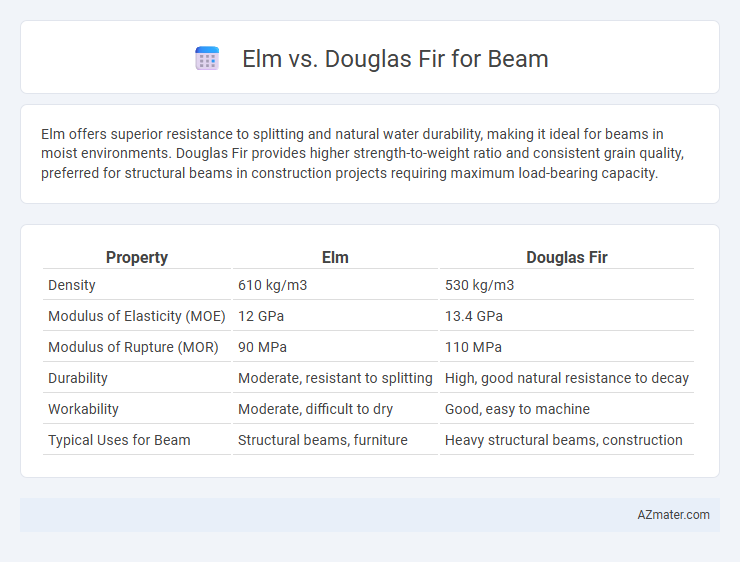Elm offers superior resistance to splitting and natural water durability, making it ideal for beams in moist environments. Douglas Fir provides higher strength-to-weight ratio and consistent grain quality, preferred for structural beams in construction projects requiring maximum load-bearing capacity.
Table of Comparison
| Property | Elm | Douglas Fir |
|---|---|---|
| Density | 610 kg/m3 | 530 kg/m3 |
| Modulus of Elasticity (MOE) | 12 GPa | 13.4 GPa |
| Modulus of Rupture (MOR) | 90 MPa | 110 MPa |
| Durability | Moderate, resistant to splitting | High, good natural resistance to decay |
| Workability | Moderate, difficult to dry | Good, easy to machine |
| Typical Uses for Beam | Structural beams, furniture | Heavy structural beams, construction |
Introduction to Elm and Douglas Fir as Beam Materials
Elm and Douglas Fir are popular choices for beam materials due to their unique structural properties. Elm is valued for its interlocking grain, which provides exceptional resistance to splitting and strong load-bearing capacity, making it ideal for heavy-duty beams. Douglas Fir offers high strength-to-weight ratio and excellent stiffness, commonly used in construction for durable, reliable beams capable of supporting significant weight over long spans.
Strength and Durability Comparison
Elm beams offer excellent strength and natural resistance to splitting, making them suitable for heavy load-bearing structures. Douglas Fir, known for its high strength-to-weight ratio, provides superior durability and dimensional stability, often outperforming Elm in long-term structural applications. Both woods have notable resilience, but Douglas Fir's consistent grain pattern grants it a slight advantage in strength and durability for beams.
Workability and Ease of Construction
Elm wood is favored for beam work due to its exceptional workability, featuring interlocking grain that resists splitting and allows for smooth shaping and fastening. Douglas Fir, known for its straight grain and uniform texture, offers ease of construction through consistent cutting and nailing performance, making it a common choice for structural beams. While Elm may require more skill to handle its complex grain, Douglas Fir provides reliable stability and simpler machining, ideal for most building projects.
Cost Analysis: Elm vs Douglas Fir
Elm beams typically cost more than Douglas Fir due to their lower availability and slower growth rates, which impact timber supply. Douglas Fir offers a cost-effective option with faster growth and higher yield, making it popular in construction where budget constraints are critical. When evaluating beam options, factoring in Elm's premium price against Douglas Fir's affordability and comparable structural strength is essential for budget-conscious projects.
Resistance to Pests and Decay
Elm offers moderate resistance to decay but is more vulnerable to insect infestations compared to Douglas Fir, which is known for its superior natural resistance to both pests and decay. Douglas Fir contains natural resins and oils that enhance its durability in outdoor and structural applications, reducing the need for chemical treatments. This makes Douglas Fir a preferred choice for beams requiring long-term performance and minimal maintenance in pest-prone or moist environments.
Appearance and Aesthetic Considerations
Elm beams feature a distinctive interlocking grain pattern with rich, warm tones ranging from light golden to reddish-brown, creating a visually striking and rustic aesthetic. Douglas Fir beams exhibit a more uniform and straight grain with a consistent reddish hue, lending a clean, modern, and polished look to architectural designs. The choice between Elm and Douglas Fir impacts the visual warmth and character of a space, with Elm offering a unique texture and Douglas Fir providing a sleek, classic appearance.
Sustainability and Environmental Impact
Elm and Douglas Fir beams differ significantly in sustainability and environmental impact; Douglas Fir is more widely available and grows faster, allowing for more sustainable harvesting practices and reforestation potential. Elm, often sourced from reclaimed or urban trees, contributes to waste reduction but faces limited supply and slower growth, impacting its overall sustainability. Selecting Douglas Fir beams supports lower carbon footprints through efficient growth cycles, while Elm beams excel in promoting recycling and urban forestry conservation efforts.
Load-Bearing Capacity Differences
Douglas Fir beams exhibit superior load-bearing capacity compared to Elm due to their higher density and structural strength, making them ideal for heavy structural applications. Elm's load-bearing capacity is moderate but less consistent, as its grain irregularities can affect uniform stress distribution under load. For construction demanding maximum stability and heavier loads, Douglas Fir remains the preferred choice among engineers and builders.
Availability and Sourcing
Elm beams are less commonly available than Douglas Fir due to the scarcity of mature elm trees, largely affected by Dutch elm disease, resulting in limited sourcing opportunities primarily from reclaimed wood suppliers. Douglas Fir is widely abundant in North America and Pacific Northwest regions, making it highly accessible and sustainably sourced from well-managed forests. The high availability and renewable sourcing options make Douglas Fir a preferred choice for structural beams in construction projects requiring reliable supply chains.
Best Applications: Which to Choose for Your Project
Elm offers excellent resistance to splitting and warping, making it ideal for curved or irregularly shaped beams in decorative or architectural projects. Douglas Fir provides superior strength and stiffness, making it the preferred choice for structural beams in construction requiring high load-bearing capacity. Choose Elm for aesthetic, intricate designs and Douglas Fir for robust, reliable support in heavy-duty framing applications.

Infographic: Elm vs Douglas Fir for Beam
 azmater.com
azmater.com